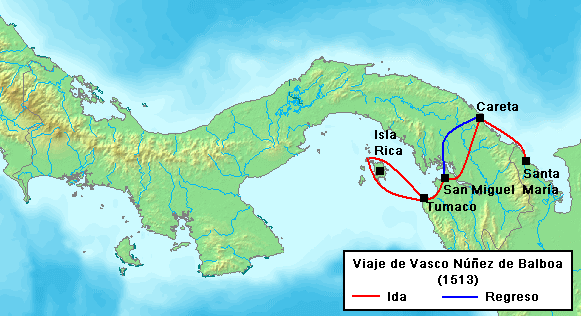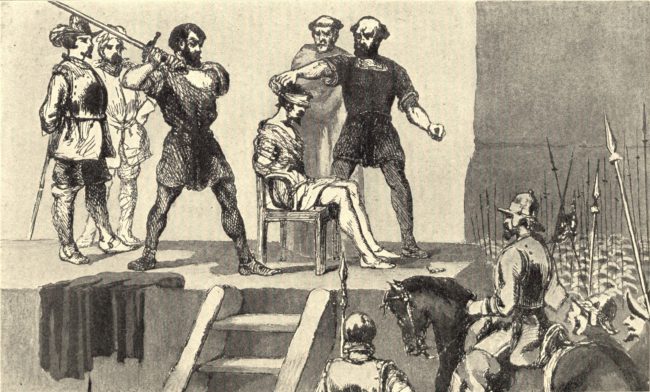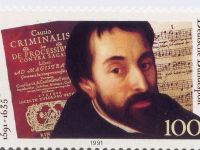
Vasco Núñez de Balboa (1475 – 1519)
On September 25, 1513, Spanish conquistador and explorer Vasco Núñez de Balboa discovered the legendary Southern Ocean, having crossed the Isthmus of Panama facing the Pacific Ocean.
Núñez de Balboa – Early Years
Núñez de Balboa came from an impoverished Galician noble family. Like many adventurers, news of the land discovered by Columbus in 1492, with its wealth of gold, prompted him to make the journey to the New World. In 1500, as a simple sailor, he participated in the expedition of Rodrigo de Bastidas to explore the Colombian and the northern coast of the Strait of Panama. He then settled in Hispaniola (Haiti) in 1501 as a pioneer farmer. There he raised pigs, but he did not come to wealth. Like many others, he spent his money in speakeasies and ran up debts.
On Expedition as a Stowaway
In 1510, Núñez de Balboa had so many debts that he decided to flee the island. At that time, a lawyer named Martín Fernández de Enciso equipped a ship to establish a settlement on the north coast of Urabá (Colombia) and exploit the lands there. Núñez de Balboa sensed a favorable opportunity to escape his creditors. Since the ship was heavily guarded by Enciso, Balboa hid in an empty provisions crate and had friends carry him aboard. Only after the ship had been at sea for two days and he knew that they would not turn back because of him, did the stowaway reveal himself. Enciso was initially very angry and wanted to abandon Núñez de Balboa on the nearest beach. But before this could happen, they encountered another Spanish ship led by Francisco Pizarro. The crew reported that they were the last survivors of a settlement whose inhabitants had been killed by the swamp climate and poison darts from the indigenous population. Now the Enciso crew did not want to continue. Núñez de Balboa explained that he knew the entire coast of Central America and remembered that at that time he had found a place called Darién on the banks of a gold-bearing river where there were friendly inhabitants. The crew followed his suggestion to go to this place. Enciso was deposed as leader; Núñez de Balboa became the expedition leader and captain general. Once at the destination, Balboa founded what was possibly the first permanent settlement of the Spaniards in continental America: Santa María la Antigua del Darién.
Governor of Darién
In December 1510, Balboa was appointed governor of Darién by King Ferdinand V of Spain. Enciso, however, was on his way to Spain in the meantime to bring charges against Balboa for his mutiny. In 1511, Núñez de Balboa undertook an expedition into the interior. In his search for gold, many Indians were killed and robbed. One day he met the chief Careta, who suggested that he form an alliance with his tribe instead of making enemies of the natives. Balboa accepted the offer and married the chief’s daughter. Together with Careta, he then subjugated the Indian tribes in the neighborhood. In 1513, the most powerful chief in the area, Comagre, heard about this. He invited Balboa and his companions to his spacious house. Without being asked, he gave his guests 4000 ounces of gold. No sooner had he distributed the gift than his guests went at each other with swords and fists, for each wanted to secure his share. Comagre was very surprised about this behavior, because for him gold was an ordinary metal. He told his guests about a mighty lake behind the mountains and that all the rivers flowing into this lake carried gold. There was as much gold there as one desired. But it was a dangerous way. Núñez de Balboa heard this with much interest. At last there seemed to be a trace of the fabulous gold country of which he and others had dreamed for years. But the great lake also seemed very interesting to him. For many still believed that Columbus had reached Asia. But the doubts about it had become stronger and stronger. The lake could be the proof that Columbus had discovered a new part of the world.
Crossing Panama
Balboa wrote to the Spanish king requesting a force of a thousand men to discover the new sea and finally gain the gold land that Columbus had found and promised in vain that he, Núñez de Balboa, would conquer. Even before this news reached the king, Núñez de Balboa received word that a court person from Spain was on his way to try him for mutiny or return him in chains to Spain. Now Núñez de Balboa did not want to wait for the requested thousand men from Spain. He called his men together and declared his intention to cross the isthmus of Panama. His courage carried over to the others. 190 soldiers agreed to follow him. Among them was Francisco Pizarro.
On September 1, 1513, the march began. Together with hundreds of Indians as porters and numerous bloodhounds, they set out. Balboa, however, had not chosen the shortest route due to ignorance, thus prolonging the dangerous journey by several days. From the beginning, they had to make their way through the jungle with sword and axe. Again and again they were attacked by locals. In addition, there was the heat, hurricane-like downpours and millions of mosquitoes. The path went through swamps with alligators and snakes. The ground was littered with ticks, scorpions, centipedes and ants. Rivers were crossed on homemade rafts.

Balboa’s travel route to the South Sea, 1513, image: No machine-readable author provided. Taichi assumed (based on copyright claims)., CC BY-SA 3.0 <http://creativecommons.org/licenses/by-sa/3.0/>, via Wikimedia Commons
Many soldiers became sick and weak. Núñez de Balboa ordered that all who were sick with fever and weak should stay behind. Once, when the expedition had to go back a bit because of a rock wall, only a few remains covered with ants were found of the sick people left behind. After seeing this, more sick people were killed immediately to spare them this gruesome torture. After three weeks, only 69 of the 190 soldiers were still alive. Then they arrived at the mountain from whose summit the great lake was to be seen. Núñez de Balboa ordered the team to stop. No one was to follow him, because he did not want to share this first view of the unknown ocean, but to have been for eternity the first Spaniard, the first European and the first Christian to see the new ocean. On September 25, 1513, in the morning at eleven o’clock, he was finally the first European to see the Pacific Ocean — or more precisely the Gulf of San Miguel, a bay of the Gulf of Panama – from the American continent, and was thus possibly the first to discover the continental characteristic of America, although it had already been postulated a few years earlier by Amerigo Vespucci,[5] who, through accurate observations, had established distinct peculiarities of the fauna and flora of America.
After looking at the sea for a long time, he called his comrades to share his joy and pride. Four days later, Núñez de Balboa took a few steps into the sea at the mouth of the Saban River and, finding salty world sea water, took possession of the “southern sea” (mar del sur) for his king. The Spaniards found gold and pearls on the coast. All the bags and sacks were stuffed with these precious items and they set off on their return journey. A native told Núñez de Balboa about another land called Birù in the south with immense treasures, the first news about the Inca Empire in Peru. This gave Balboa a target for further conquest. But first he had to return to Darién with the few survivors. Núñez, himself near death, arrived back in Darién on January 19, 1514.

Image of the execution of Balboa in Vasco Nuñez de Balboa by Frederick A. Ober (1906)
Imprisonment and Death
Again he asked the Spanish king for a force of 1000 men for the conquest of Peru, but this did not happen. Due to intrigues at the Spanish court, he was replaced as governor of Darién by the Spanish soldier (and his later father-in-law) Pedrarias Dávila. The Spanish king heard of Núñez de Balboa’s discoveries and appointed him captain general of the provinces of Coiba and Panama and governor of the South Seas in July 1515. Núñez de Balboa subsequently made several more discoveries along the coast of Panama. But the relationship with his father-in-law Pedro Arias Dávila, described as cruel and greedy for money, became worse and worse. Finally, Dávila had him arrested for an alleged conspiracy. Without charge and without the possibility of defense, Núñez de Balboa was beheaded together with four friends in the town of Acla in Panama in January 1519
Biografía de Vasco Núñez de Balboa, [4]
References and Further Reading:
- [1] Balboa at All About Explorers
- [2] The Discovery Of The Pacific By Balboa
- [3] Balboa at Heritage History
- [4] Biografía de Vasco Núñez de Balboa, Historia del Nuevo Mundo @ youtube
- [5] Amerigo Vespucci and the New World, SciHi Blog
- [6] Stefan Zweig: Sternstunden der Menschheit. Flucht in die Unsterblichkeit im Projekt Gutenberg-DE
- [7] Spate, O.H.K. (2020). “‘South Sea’ to ‘Pacific Ocean: A Note on Nomenclature”. In Ballantyne, Tony (ed.). Science, Empire and the European Exploration of the Pacific. Routledge. p. 38.
- [8] Asenjo García, Frutos (1991). Vasco Núñez de Balboa: El descubrimiento del Mar del Sur. Madrid: Sílex Ediciones.
- [9] Compendio de Historia de Panamá . pp. 156–171. Juan B. Sosa y Enrique J. Arce. Panamá, October, 1911
- [10] Herbermann, Charles, ed. (1913). . Catholic Encyclopedia. New York: Robert Appleton Company.
- [11] Vasco Núñez de Balboa at Wikidata
- [12] Timeline of Spanish Conquistadors, via Wikidata and DBpedia





